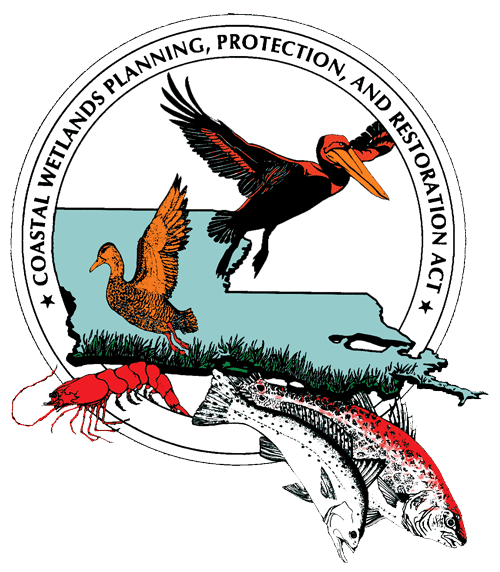
This release, related photographs and graphics are available at https://www.usgs.gov/news/usgs-louisiana-s-rate-coastal-wetland-loss-continues-slow.
News Release
July 12, 2017
Brady Couvillion, research geographer 225-578-7484 couvillionb@usgs.gov
Heather Dewar, public affairs specialist 352-264-3542 hdewar@usgs.gov
Louisiana has been losing coastal wetlands since at least the 1930s, but the long-term rate of land loss has slowed since its peak in the 1970s, and U.S. Geological Survey scientists have recently found a further slowing since 2010.
“The lack of a major hurricane strike since 2008 is probably the main reason we’ve seen a decrease in the rate of land loss,” said USGS research geographer Brady Couvillion, the lead author of a new report on land area change in coastal Louisiana. “Although ongoing government and private efforts to conserve the state’s coastal wetlands are also a contributing factor.”
The report estimates that Louisiana’s coastal parishes have lost 5,197 square kilometers (2,006 square miles) of land from 1932 to 2016. The margin of error for the period covered in this new report is plus or minus 443 square kilometers, or 171 square miles.
Overall, the 2016 land area estimate, based on satellite imagery, is approximately 16 square miles greater than was estimated in 2010, when the last update on coastal land change in Louisiana was published. However, once a computer model corrected for potential sources of error such as changing water levels, a statistical analysis showed that land area has actually declined by 151 square kilometers, or 58 square miles, since 2010.
The difference between the 2010 and 2016 estimates is well within the margin of error associated with measuring coastal Louisiana’s ever-changing wetlands, the researchers said.
Land area estimates can vary due to the influence of rivers, tides, and approaching storms, Couvillion explained. So the researchers used 21 different estimates spanning 84 years, and applied statistical methods to account for as much variability as possible.
Their analysis shows that “rates of land area loss have continued to decrease, as they have since the 1970s,” Couvillion said.
“The most recent observations are promising, but it is not clear that they will persist,” Couvillion said. “Coastal wetland change is a long-term process.”
Coastal wetlands help to reduce inland flooding and erosion and act as essential habitat for fish, shellfish and other wildlife. Louisiana’s coastal wetlands provide benefits far beyond its borders, supporting more than 30 percent of the United States’ commercial fishing catch and protecting five important shipping ports. An estimated 20 percent of the nation’s oil and gas is pumped from or transported through these wetlands.
About half of the United States’ wetlands have been lost over the past 200 years. The losses are greatest in Louisiana, where about one-quarter of the state’s wetlands – an area the size of Delaware – have been lost since the 1930s.
The region’s coastal wetlands are vulnerable to natural and human influenced processes, such as sea-level rise, subsidence and storm-driven erosion. Once, sediments carried down the Mississippi River and deposited in its delta naturally renewed the wetlands. But constructed dams, levees and flood control structures have interrupted that process. In an effort to reverse that trend federal, state, and local governments, universities, industries and citizens’ groups are working on wetland construction and restoration projects.
The USGS uses historical surveys, aerial imagery and satellite data to track landscape changes in coastal Louisiana over time. For the latest study, “Land Area Change in Coastal Louisiana (1932 – 2016),” Couvillion and other scientists at the USGS’ Wetland and Aquatic Research Center compiled and analyzed data from a variety of historical and modern sources.
The researchers found that over the 84 years studied, Louisiana’s rates of loss ranged from a high of 83.5 square kilometers (32.0 square miles) per year to a more moderate 28.0 square kilometers (10.8 square miles) per year. While land loss rate is not a constant, this equates to losing an average of an American football field’s worth of coastal wetlands in 34 minutes when losses were rapid, or in 100 minutes at more recent rates.
The researchers cited several possible reasons for the slowing of wetland losses, including:
- Recovery from some short-term effects of four hurricanes which struck the region in 2005 and 2008.
- The lack of major hurricane effects in coastal wetlands in the past eight years.
- A possible slowing of subsidence rates.
- Successes in coastal restoration work.
- Relocation and retirement of some oil and gas facilities. Hydrocarbon extraction in the coastal zone has declined from its peak in the late 1960s.
- The fact that many wetlands in the most exposed positions have already been lost.
The new report’s key finding “does not indicate that coastal wetland loss has ceased to be a serious issue,” the authors wrote. “A major hurricane impact could quickly change the trajectory of the rates. Sea-level rise is projected to increase at an exponential rate, and that would also expedite the rate of wetland loss.”
USGS provides science for a changing world. Visit USGS.gov, and follow us on Twitter @USGS and our other social media channels. Subscribe to our news releases via e-mail, RSS or Twitter.
Links and contacts within this release are valid at the time of publication.
###
To subscribe, send an email from the address you want subscribed to: ListServer@nwrccom.cr.usgs.gov with the subject "subscribe cwppra" without the quotation marks. |
Connect with us: |
|
Submit CWPPRA Newsflash Requests to: ladnerk@usgs.gov |
||

